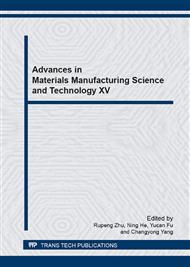p.116
p.120
p.126
p.130
p.136
p.141
p.145
p.150
p.155
Turning of Cast Inconel 718 with Coated Carbide and Whisker Reinforced Ceramic Tools
Abstract:
Nickel-based alloy is known as one of the most difficult-to-machine materials. During the machining process, the high temperature coupled with high strength and work hardening leads to excessive tool wear, short tool life, low productivity, etc. Tool life and material removal rate are the two targets of rough machining. In this paper, some turning tests are conducted to investigate the tool lives and material removal rate of coated carbide tools and whisker reinforced ceramic tools. The results show that notch wear is the dominant failure mode for whisker reinforced ceramic tools while severe flank wear and micro-chipping for coated carbide tools. The whisker reinforced ceramic tools are more effective in machining nickel-based alloys than the coated carbide tools both in tool life and material removal rate.
Info:
Periodical:
Pages:
136-140
Citation:
Online since:
October 2013
Authors:
Keywords:
Price:
Сopyright:
© 2014 Trans Tech Publications Ltd. All Rights Reserved
Share:
Citation:


